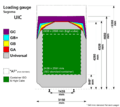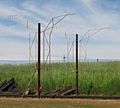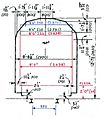Loading gauge facts for kids
A loading gauge is like a special rule that tells us the biggest size a train or its cargo can be. It makes sure trains can safely pass under bridges, through tunnels, and past other things near the tracks. Think of it as a giant measuring frame that every train must fit through!
Contents
What is a Loading Gauge?
A loading gauge sets the maximum height and width for railway vehicles and their loads. It's super important for safety! Without these rules, a train might hit a bridge, get stuck in a tunnel, or crash into other structures along the tracks.
Why are Loading Gauges Important?
Imagine a train carrying tall containers. If the containers are too high, they could scrape the top of a tunnel or hit the underside of a bridge. This could cause serious damage or even an accident. The loading gauge prevents this by making sure everything on the train, including the train itself, fits perfectly.
It's also important for track gauge. The track gauge is the distance between the two rails. Even if the track gauge is the same in different places, the loading gauge can be different. This means a train that fits on one railway might not fit on another, even if they use the same width of tracks.
Keeping Trains Safe
The space between a train and the tunnel or bridge is called the clearance space. This space is often very small, especially in old tunnels like those on the London Underground. That's why it's so important for trains to be the right size.
Different Sizes Around the World
Loading gauges can be different in various countries and even on different parts of the same railway network. For example, in the London Underground, there are two main types of trains:
- Sub-surface trains: These are wider and taller, like the ones on the Metropolitan line. They run just below the surface.
- Tube trains: These are smaller and narrower, like the ones on the Piccadilly line. They run in deep, round tunnels.
This is why you'll see different-sized trains on different London Underground lines. A sub-surface train wouldn't fit in a tube tunnel!
Special Trains and Cargo
Some trains are designed to carry very large or unusual loads. For example, double-stack container services in North America carry two shipping containers stacked on top of each other. These trains need a very high loading gauge.
Sometimes, very large items like parts of an airplane fuselage (the main body of the plane) are transported by rail. These also need special routes with very generous loading gauges to make sure they can pass safely.
How Loading Gauges are Checked
Railway companies use special tools and methods to check loading gauges:
- Physical frames: Sometimes, a physical frame or template is used. A train or its load must pass through this frame without touching it.
- Calibration bridges: These are structures that help measure the maximum height of vehicles.
- Modern technology: Today, laser scanners and other high-tech tools can quickly check if a train or its cargo fits within the allowed size.
If a railway line needs to carry larger trains or cargo, sometimes the bridges and tunnels have to be rebuilt or made bigger. This can be a huge and expensive job, but it's necessary to upgrade the railway for modern needs.
Images for kids
-
The clearance space between a train and the tunnel is often small. Pictured is a London Underground Northern line train at Hendon Central.
-
The London Underground utilises differing loading gauges: a Metropolitan line A Stock sub-surface train (left) passes a Piccadilly line 1973 Stock tube train (right).
-
Double-decker carriage as used on French TGV railways.
-
Boeing 737 Next Generation fuselage being transported by rail.
-
Structure gauge limiting the height of vehicles for Ducharme Bridge.
See also
 In Spanish: Gálibo ferroviario para niños
In Spanish: Gálibo ferroviario para niños


















